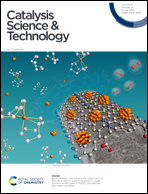Bismuth MOF-derived BiOBr/Bi24O31Br10 heterojunctions with enhanced visible-light photocatalytic performance†
Abstract
In this work, a hierarchical BiOBr/Bi24O31Br10 heterojunction is prepared for the first time from a bismuth MOF (Bi-BTC) by a facile bromination–annealing route. Since cetyltrimethylammonium bromide (CTAB) is used as the Br element source, the heterojunction constructed of BiOBr and Bi24O31Br10 nanosheets maintains the rod-like morphology of the original MOF. In photocatalytic degradation tests, the BiOBr/Bi24O31Br10 heterojunction exhibits much higher photocatalytic activity than pure Bi2O3, and the heterojunctions annealed at 450 °C show the best photocatalytic activity among samples prepared at various temperatures. The heterojunction also shows good pH adaptability, good reusability, and structural stability for RhB degradation, and the TOC results and full UV-vis spectra confirm its good mineralization performance under visible-light irradiation. Based on the photo-electrochemical characterization and free radical tests, a photocatalytic enhancement mechanism over the heterojunction and different photocatalytic reactions in the presence of photo-induced h+, ˙O2− and 1O2 are reasonably proposed.



 Please wait while we load your content...
Please wait while we load your content...